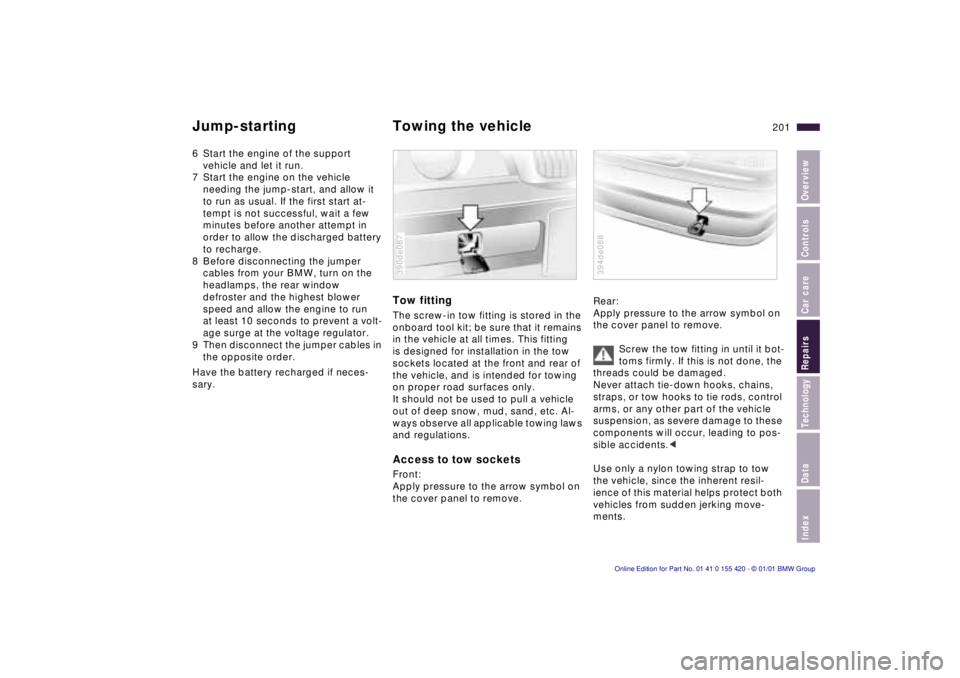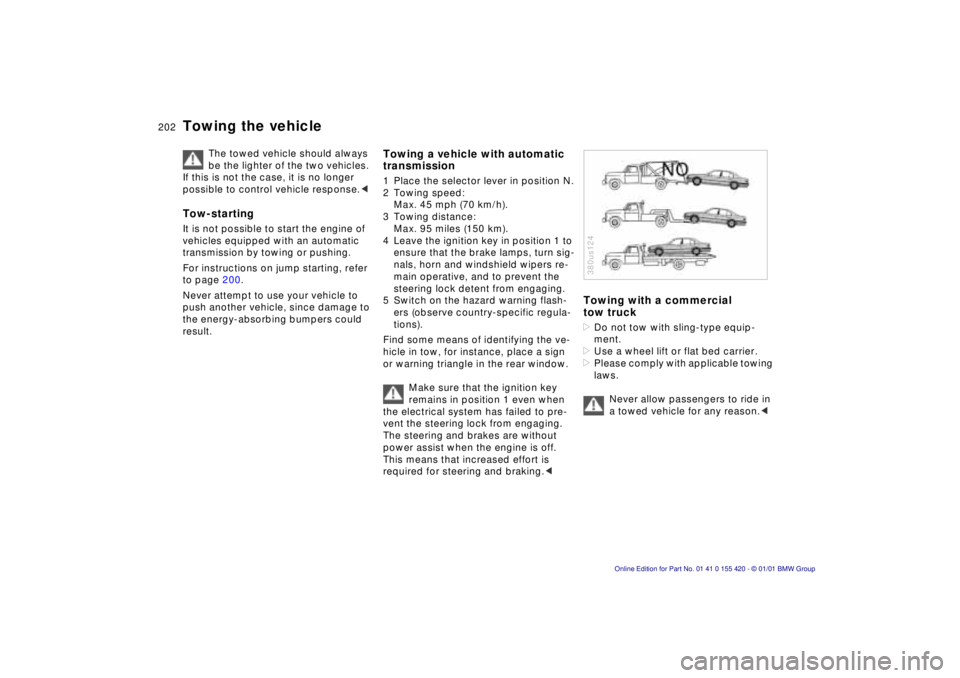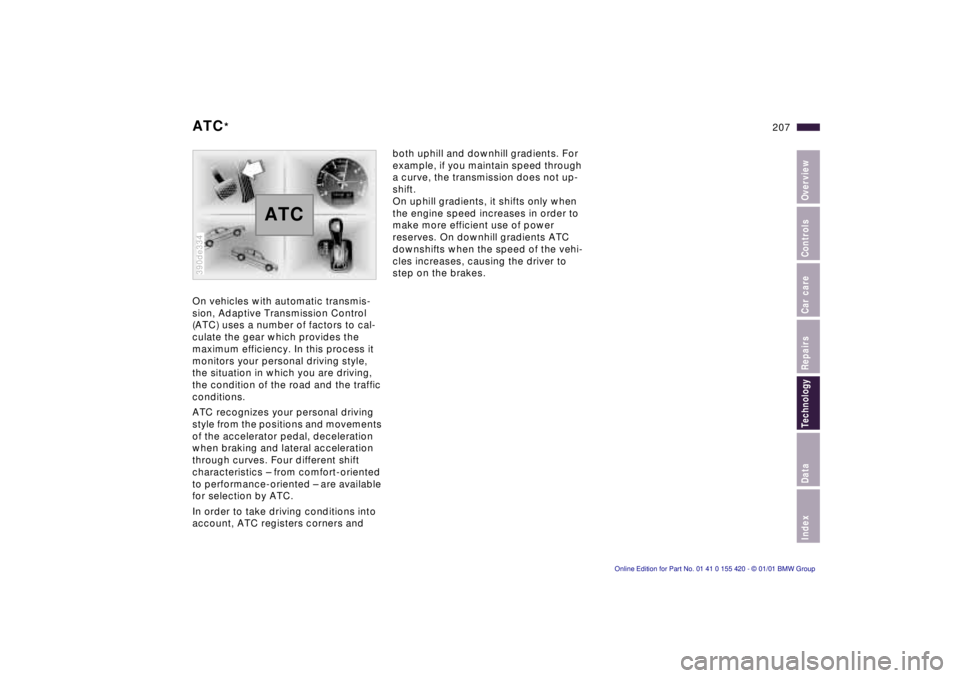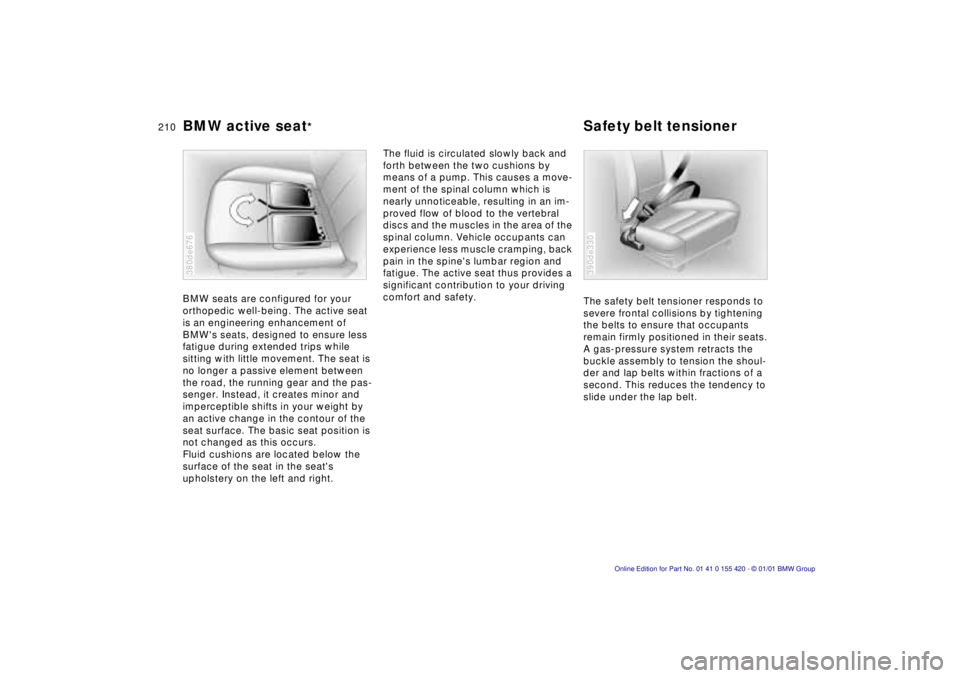Page 201 of 238

Index
Data
Technology
Repairs
Car care
Controls
Overview
201nJump-starting Towing the vehicle
6 Start the engine of the support
vehicle and let it run.
7 Start the engine on the vehicle needing the jump-start, and allow it
to run as usual. If the first start at-
tempt is not successful, wait a few
minutes before another attempt in
order to allow the discharged battery
to recharge.
8 Before disconnecting the jumper cables from your BMW, turn on the
headlamps, the rear window
defroster and the highest blower
speed and allow the engine to run
at least 10 seconds to prevent a volt-
age surge at the voltage regulator.
9 Then disconnect the jumper cables in the opposite order.
Have the battery recharged if neces-
sary.
Tow fitting
The screw-in tow fitting is stored in the
onboard tool kit; be sure that it remains
in the vehicle at all times. This fitting
is designed for installation in the tow
sockets located at the front and rear of
the vehicle, and is intended for towing
on proper road surfaces only.
It should not be used to pull a vehicle
out of deep snow, mud, sand, etc. Al-
ways observe all applicable towing laws
and regulations.
Access to tow sockets
Front:
Apply pressure to the arrow symbol on
the cover panel to remove.
390de087
Rear:
Apply pressure to the arrow symbol on
the cover panel to remove.
Screw the tow fitting in until it bot-
toms firmly. If this is not done, the
threads could be damaged.
Never attach tie-down hooks, chains,
straps, or tow hooks to tie rods, control
arms, or any other part of the vehicle
suspension, as severe damage to these
components will occur, leading to pos-
sible accidents. <
Use only a nylon towing strap to tow
the vehicle, since the inherent resil-
ience of this material helps protect both
vehicles from sudden jerking move-
ments.
394de088
Page 202 of 238

202nTowing the vehicle
The towed vehicle should always
be the lighter of the two vehicles.
If this is not the case, it is no longer
possible to control vehicle response. <
Tow-starting
It is not possible to start the engine of
vehicles equipped with an automatic
transmission by towing or pushing.
For instructions on jump starting, refer
to page 200.
Never attempt to use your vehicle to
push another vehicle, since damage to
the energy-absorbing bumpers could
result.
Towing a vehicle with automatic
transmission
1 Place the selector lever in position N.
2 Towing speed: Max. 45 mph (70 km/h).
3 Towing distance: Max. 95 miles (150 km).
4 Leave the ignition key in position 1 to ensure that the brake lamps, turn sig-
nals, horn and windshield wipers re-
main operative, and to prevent the
steering lock detent from engaging.
5 Switch on the hazard warning flash- ers (observe country-specific regula-
tions).
Find some means of identifying the ve-
hicle in tow, for instance, place a sign
or warning triangle in the rear window.
Make sure that the ignition key
remains in position 1 even when
the electrical system has failed to pre-
vent the steering lock from engaging.
The steering and brakes are without
power assist when the engine is off.
This means that increased effort is
required for steering and braking. <
Towing with a commercial
tow truck
> Do not tow with sling-type equip-
ment.
> Use a wheel lift or flat bed carrier.
> Please comply with applicable towing
laws.
Never allow passengers to ride in
a towed vehicle for any reason. <
380us124
Page 207 of 238

Index
Data
Technology
Repairs
Car care
Controls
Overview
207n
On vehicles with automatic transmis-
sion, Adaptive Transmission Control
(ATC) uses a number of factors to cal-
culate the gear which provides the
maximum efficiency. In this process it
monitors your personal driving style,
the situation in which you are driving,
the condition of the road and the traffic
conditions.
ATC recognizes your personal driving
style from the positions and movements
of the accelerator pedal, deceleration
when braking and lateral acceleration
through curves. Four different shift
characteristics – from comfort-oriented
to performance-oriented – are available
for selection by ATC.
In order to take driving conditions into
account, ATC registers corners and
390de334
ATC
both uphill and downhill gradients. For
example, if you maintain speed through
a curve, the transmission does not up-
shift.
On uphill gradients, it shifts only when
the engine speed increases in order to
make more efficient use of power
reserves. On downhill gradients ATC
downshifts when the speed of the vehi-
cles increases, causing the driver to
step on the brakes.
ATC*
Page 208 of 238

208nASC+T/DSC*
Precision sensors monitor the number
of revolutions of the wheels. When
equipped with DSC, they also monitor
steering angle, lateral acceleration,
brake pressure and the movement of
the vehicle around its vertical axis.
If differences in the wheel speeds
occur, the system counteracts the dan-
ger of wheelspin by reducing torque. If
necessary, the system also responds
with additional brake applications at the
rear wheels, and at all 4 wheels with
DSC.
In addition, DSC permanently monitors
the vehicle's current operating condi-
tion and compares it with an ideal con-
dition that is calculated from the sen-
sor's signals. If deviations from this
occur (understeering or oversteering,
for instance), DSC can stabilize the
vehicle in the fraction of a second by
reducing engine output and with the
assistance of braking intervention at in-
dividual wheels. As a result, dangerous
skids can be prevented even as they
are just beginning. You may need some time to become
accustomed to this system intervention.
However, it guarantees optimum drive
force and driving stability.
The braking intervention may be
accompanied by a certain degree of
noise.
Page 210 of 238

210nBMW active seat*Safety belt tensioner
BMW seats are configured for your
orthopedic well-being. The active seat
is an engineering enhancement of
BMW's seats, designed to ensure less
fatigue during extended trips while
sitting with little movement. The seat is
no longer a passive element between
the road, the running gear and the pas-
senger. Instead, it creates minor and
imperceptible shifts in your weight by
an active change in the contour of the
seat surface. The basic seat position is
not changed as this occurs.
Fluid cushions are located below the
surface of the seat in the seat's
upholstery on the left and right.
380de676
The fluid is circulated slowly back and
forth between the two cushions by
means of a pump. This causes a move-
ment of the spinal column which is
nearly unnoticeable, resulting in an im-
proved flow of blood to the vertebral
discs and the muscles in the area of the
spinal column. Vehicle occupants can
experience less muscle cramping, back
pain in the spine's lumbar region and
fatigue. The active seat thus provides a
significant contribution to your driving
comfort and safety.
The safety belt tensioner responds to
severe frontal collisions by tightening
the belts to ensure that occupants
remain firmly positioned in their seats.
A gas-pressure system retracts the
buckle assembly to tension the shoul-
der and lap belts within fractions of a
second. This reduces the tendency to
slide under the lap belt.
390de330
Page 217 of 238
Index
Data
Technology
Repairs
Car care
Controls
Overview
Overview
Controls and features Operation, care
and maintenance
Technical data Index
Advanced technology
217
n
Owner service procedures
Engine specifications 218
Dimensions 219
Weights 221
Capacities 223
Electrical system 224
Drive belts 224
Data
Page 218 of 238
218n
BMW 525i/sport wagon BMW 530i BMW 540i/sport wagon
Displacement
Number of cylinders cu in (cm
m) 152.2 (2,494)
6 181.8 (2,979)
6268.4 (4,398)
8
Maximum output
at engine speed hp
rpm184
6,000 225
5,900282
5,400
Maximum torque
at engine speed Ib ft (Nm)
rpm175 (236)
3,500 214 (289)
3,500324 (440)
3,600
Compression ratio e10.5 10.2 10.0
Stroke
Bore in (mm)
in (mm)2.95 (75.0)
3.31 (84.0) 3.53 (89.6)
3.31 (84.0)3.26 (82.7)
3.62 (92.0)
Fuel-injection system Digital-electronic engine-management system
Engine specifications
Page 223 of 238
Index
Data
Technology
Repairs
Car care
Controls
Overview
223nCapacities
Notes
Fuel tank
Reserve gal. (liters)
gal. (liters)approx. 18.5 (approx. 70)
approx. 2.0 (approx. 8) – BMW 525i,
530i
approx. 2.5 (approx. 10) – BMW 540i Fuel specification: page
29
Windshield washer system
with headlamp washer system
Intensive cleaning system quarts (liters)
quarts (liters)
quarts (liters)approx. 3.7 (approx. 3.5)
approx. 6.3 (approx 6.0)
approx. 1.1 (approx 1.0) For details: page
164
Cooling system including heater
circuit quarts (liters) 11.1 (10.5) – BMW 525i, 530i
12.7 (12.0) – BMW 540i For details: page
167
Engine with oil filter change quarts (liters) 6.9 (6.5) – BMW 525i, 530i 7.9 (7.5) – BMW 540i"BMW High Performance
Synthetic Oil."
For details: page
167
Manual transmission, automatic
transmission and differential – – Lifetime fluid, no fluid
change required